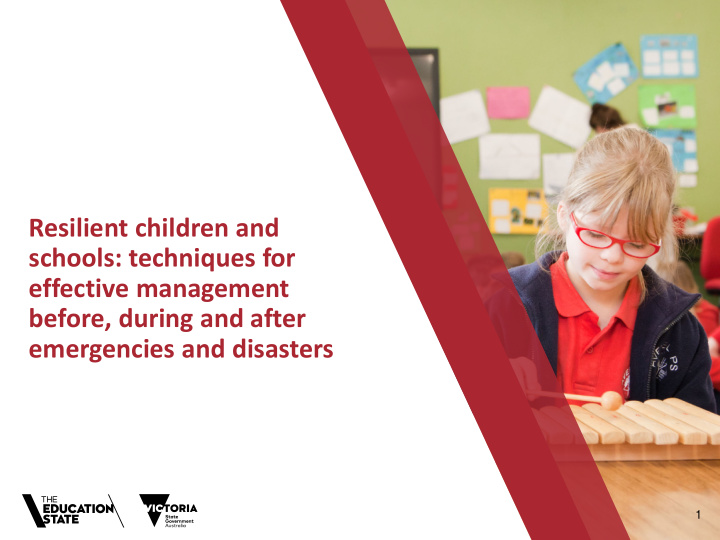



Resilient children and schools: techniques for effective management before, during and after emergencies and disasters 1
2
Resilience and Recovery from Trauma Most students recover over time, yet the reality is that a significant number of students cannot re- engage in the learning process or return to normal functioning without adult help and support. 3
Good recovery begins with … 4
5
6
The ecological perspective – The child is part of many systems – Family, school, clubs, social networks, culture, religion, ethnicity – The child is growing, learning & developing – The child’s needs are linked with their developmental level, personality, previous experiences and the experiences they have of the incident and their ability to make sense of it and maintain a sense of efficacy 7
8
5 intervention principles 5 Essential elements of immediate & mid term mass intervention: Empirical evidence. Hobfoll et al, 2009 1. Promotion of a sense of safety 2. Calming 3. A sense of self & community efficacy 4. Connectedness 5. Hope 9
10
11
What does a resilient child look like in the context of our work? - Skills - Knowledge - Attributes 12
What does a resilient school community look like? 13
Resilient communities are healthy, knowledgeable, have the ability to assess, monitor, manage risks while learning new skills and building on past experiences. They have the capacity to identify problems, establish priorities and act. They are supported by good infrastructure and services. They are flexible, resourceful and have the capacity to accept uncertainty and proactively respond . 14
15
Children’s participation • Can (or should) children participate in these kinds processes and activities? • If so, how? • What are the benefits, challenges obstacles? • How do we demonstrate and share success?
What is participation? “The process of sharing decisions which affect one’s life and the life of the community in which one lives” – Roger Hart, 1992
Why do it? • Children develop the confidence and competence to participate in EM through real life experience. • EM policy and practice is more likely to meet children’s needs when they participate in decision-making. • Children’s contributions can reduce risk and increase resilience for the whole community. • Promotes lifelong participation and engagement (???) It’s a legitimate form of community engagement!
United Nations Convention on the Rights of the Child Article 12: The child who is capable of forming his or her own views has the right to express those views freely in all matters affecting the child, the views of the child being given due weight in accordance with the age and maturity of the child.
Hart’s ladder of participation Children have ideas, set up projects and come to adults for advice, discussion, and support. The adults don’t direct but offer their expertise for young people to consider. Children have the initial idea and decide on how the project is to be carried out. Adults might be available but don’t take charge. Adults have the initial idea but children are involved in every step of the planning and implementation. Children’s views are considered, and they are involved in making decisions. The project is designed and run by adults but children are consulted. They have a full understanding of the processes and their opinions are taken seriously. Adults decide on the project and children volunteer for it. The children understand the project. They know who decided to involve them and why. Children may appear to be given a voice but they have little say on the topic or on the way their views are communicated. Children are used to look good or bolster a campaign or programme. Adults have complete control and often don’t work in the best interests of the child. Children have no say in anything and no power to make their decisions.
Treseder’s degrees of involvement Adult initiated, shared Assigned but informed decisions with children Degrees of involvement Consulted and Child-initiated and informed directed Child initiated, shared decisions with adults
The disaster resilient school • Is there an opportunity for children to participate? • What level of participation would be appropriate or ‘doable’? • What are the potential benefits? • What obstacles or challenges might you confront? • How might you evaluate your efforts and share the learning/experience?
What next? • Do you have existing school engagement activities in which children could participate? • Is there scope to initiate new activities in which children could participate? • What support/guidance/resources do you need going forward?
Recommend
More recommend